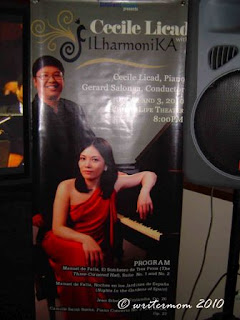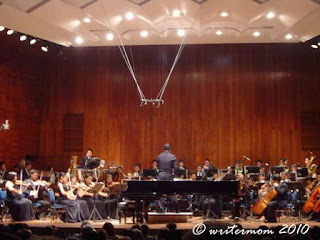My sister called me around noon yesterday. She said they have extra tickets to the Cecile Licad and FILharmoniKa’s concert last night. I didn’t have to think twice. I have heard FILharmoniKa before and love that orchestra. But I especially wanted to hear Cecile Licad play live. My eldest son, who is taking piano lessons, agreed to go with me.
Hubby and I rushed to get our grocery shopping done so Leland and I would not arrive late at the Philam Theatre in UN Avenue at 8 p.m. We made it with time to spare.
I was instantly transported to music heaven when the orchestra, conducted by Gerard Salonga, opened the program with an excellent rendition of Lupang Hinirang. Philam theater must have been built with room acoustical design in mind because the sounds reverberating throughout the whole theater were very good.
There were only four compositions played but they were long ones. The first was El Sombrero de Tres Picos (The Three-Cornered Hat) and was performed by FILharmoniKA. This is a ballet piece written by Manuel de Falla, a Spanish composer of classical music. It is filled with lively and vital passages that come from traditional Andalusian folk music.
The second piece, Noches en los Jardines de Espana (Nights in the Gardens of Spain) was also composed by Manuel de Falla. Cecile Licad joined FILharmonika on stage for this one. According to the souvenir program, Noches was originally meant as a set of nocturnes for solo piano, but was later expanded to become a piece for piano with orchestra.
Finlandia by Finnish composer Jean Sibelius was the third piece and it was performed again by FILharmoniKA. This one is a symphonic poem that is deeply etched in the Finnish national identity. It is meant to evoke images of war and an oppressed people’s struggle and eventual triumph over a larger, more powerful foe.
Last piece, again with Cecile Licad, was The Piano Concerto No. 2 in G minor, Op. 22. It was written by French composer, conductor, and pianist Charles Saint-Saens. This piano concerto is said to be considered by many as their most favorite Saint-Saens composition.
After the program, requests for an encore ensued. Cecile came back three or four times, if I remember it right, to play solo piano to the audiences’ delight. Although I am not a super fan of classical music, I do know how to play the piano (passably) and admire anyone who can magically play the instrument. Cecile deservedly earned the title “a pianist’s pianist” given her by The New Yorker and is definitely a world-class Filipino artist in her own right.
Cheers for a great night of music! I'm now off to dust my violin's case and try to resume playing again.












No comments:
Post a Comment